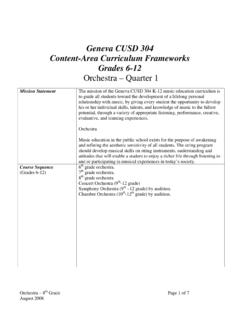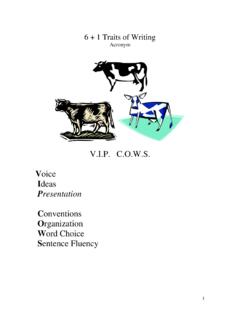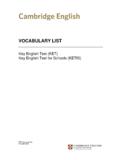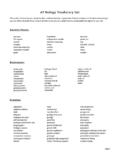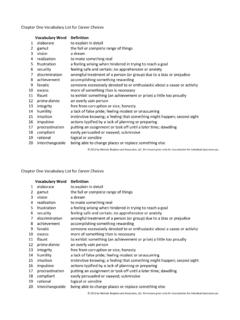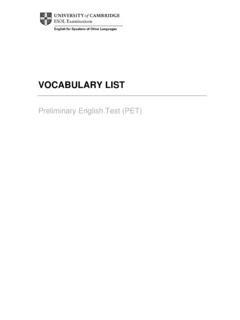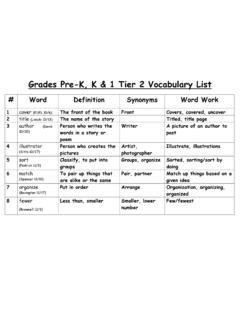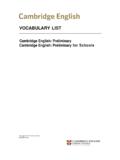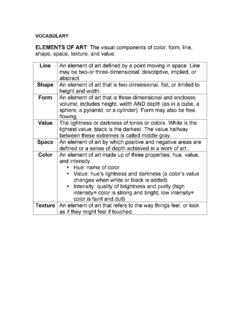Transcription of Grade 3 National Reading Vocabulary - Geneva
1 Grade 3 National Reading Vocabulary The following list contains the 800+ new Reading words that students need to master by the end of Grade 3. Students who master these Vocabulary words (along with our Grade 1 and 2 Vocabulary ) will be Reading at approximately a Grade level and typically score in the top 10% on National Reading tests (such as the Woodcock-Johnson or Stanford Achievement Test). These words are the next most-common Reading words used in Reading books after the 1200 words in our Grade 1 and Grade 2 lists .
2 Words used in our Grade Level Vocabulary lists were selected after computer analysis for word frequency of Grade level textbooks including Houghton Mifflin, Scholastic, and Accelerated Reader. To insure comprehension of test questions in a school s end-of-year testing, we also include critical test question Vocabulary ( author locate paragraph details sequence fact opinion pattern etc.). Words are organized as follows: 1st nine weeks - 238 words 2nd nine weeks - 216 words 3rd nine weeks - 252 words 4th nine weeks - 252 words TOTAL = 958 words Vocabulary Organization Although 958 total words are used in the Grade 3 list, 804 are new Reading Vocabulary words.
3 154 words in the first nine week section are review words from Grade 2. This is done to provide a much needed review of the major vowel sound and difficult Reading words from the Grade 2 list. (It has been a long summer). Words are introduced at a steady rate of 6 words per day for the first 18 weeks and 7 words per day for weeks 19-36. Friday is to be used by classroom teachers as a review and/or test day to determine mastery of the week s Vocabulary .
4 The 6 or 7 daily words are organized from most-common to least-common along common vowel sound or Reading rule categories. Word of the Day The last word in each daily column is called the Word of the Day (next to the WD). It is placed here because it is typically more difficult to learn than the other phonics based words. This difficulty occurs because it is either visually similar to other words ( went want) or its letters are not consistent with typical phonics rules ( does/duz what/wut).
5 The Word of the Day typically requires more practice to insure its complete memorization. Readiness TEST An excellent test to determine if a student is ready for the Grade 3 Program is to have him/her read the 70 review words listed in Weeks 1 and 2. If your student can read 50% correctly (35 of 70) then he/she is Reading at approximately a Grade level (2nd Grade 5th month) and should begin with our Grade 2 Program. If 75% are answered correctly (52 of 70), then he/she is Reading at approximately a Grade level and should also go back and review the Grade 2 program.
6 If your student can read the 70 words with 4 or less errors they should be ready for the Grade 3 Vocabulary Building Program. Along with Reading the words correctly, it is very important for your student to read the words fluently. Fluency is the process of Reading words easily - smoothly and without hesitation. National research has shown Vocabulary and fluency are the two essential components for achieving maximum Reading ability. The Most Progress The Least Effort With over 20 years researching Reading methods and student progress, the evidence clearly shows that teaching Reading Vocabulary words in small groups that share the same vowel sound will generate far more progress than any other method of teaching Reading .
7 Attention Teachers ! A Powerful - Powerful Tool If you are a classroom teacher and want to give your students a tremendous jump in Reading ability at the start of school, we strongly encourage you to use our Grade Level lists to test all your students in a one-on-one situation during the first week of school. Grade 4 teachers should enlist the help of assistants or parents and test each student on the Grade 3 words. Grade 3 teachers should test all students using the Grade 2 Vocabulary list.
8 Grade 2 teachers should test their students using the Grade 1 list, etc. By doing this, you are identifying critical Vocabulary that your student should have mastered before beginning their current Grade Level Vocabulary Program (remember, words from a previous Grade list occur with greater frequency in books, and therefore, are more important to have mastered). It is suggested that you print one copy (12 pages) of each Vocabulary list for each student. While this takes considerable time (and about a half ream of paper), it keeps things much more organized and allows for less confusing coding of words during the testing process.
9 (It is also quite impressive to the parents in your beginning of the year teacher conference). Testing Procedure To test a student, simply sit down at a table and ask him/her to read the words from the beginning of the list. If your student is able to read the words easily and without hesitation, you may wish to save some time and ask them to read only the WD words (Words of the Day). If a child can read these words correctly, then he/she most likely can read the other words correctly (since the WD words are typically more difficult).
10 When your student reads a word incorrectly, it is highly beneficial to write the word the child actually said next to the list word. For example, if the word on the list is certain - and your student said curtain, you should write down curtain directly next to the list word certain. This way they can be practiced together later. You should also record if your student hesitates on a word. For example, if your student hesitates 5 seconds on the word sure, you should write a 5 next to the word sure.


